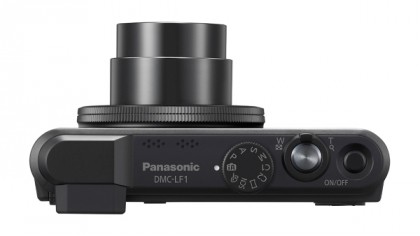Why you can trust TechRadar
For a camera that includes both a 7.1x optical zoom lens and an electronic viewfinder, the Panasonic LF1 manages to remain incredibly small. You could easily slip this into a jeans pocket, making it a good choice for those looking for a high performance back-up camera for everyday travelling.
With its rounded corners and smooth body material, Panasonic has clearly put some effort into creating an attractive body for this camera. It's less chunky than the Panasonic LX7, and generally has a much more understated feel.
On top of the camera is a mode dial for switching between the various different options available, including fully automatic (iA) and PASM modes.

There's also space here for up to two groups of custom settings, which is useful if you often find yourself shooting one particular type of subject or scene. It's also on the mode dial that you'll find digital filters mode, scene mode and panoramic mode.
Because the Panasonic LF1's mode dial is fairly fluid, it can be quite easy to accidentally knock it away from the setting you want it to be on, especially as you pull it out of a pocket, so you may find you need to be careful of that.
The back of the camera sees a fairly standard compact camera layout. The majority of the buttons can be found within easy reach of the thumb, making it handy to use one-handed.

A scrolling dial found on the back of the camera is used to make changes, such as to the aperture, depending on the mode being used. There's also a scrolling dial around the lens that can control these functions. This dial can also be customised to control something else, if you want to work slightly differently.
Both of these dials can also be used to navigate through the Quick Menu, which is accessed by pressing the "trash can" button towards the bottom right of the back of the camera.
Just above the scrolling dial is the function button, which is also customisable, and can be used for a number of different functions, including setting the ISO or white balance.

Because the Panasonic LF1 doesn't include a touchscreen, setting the autofocus point yourself can be a little fiddly. By default, to do this you would need to enter the quick menu, scroll to AF mode, hit the Display button then use the directional keys to move the point to where you need it to be.
Since this is such a laborious task, we'd recommend either leaving the focus point in the centre of the frame and recomposing, or assigning the AF point set to the customisable function button.
Panasonic has included a small electronic viewfinder on the Lumix LF1. Sadly, the company hasn't also included an eye sensor to automatically switch it on as you bring the camera to your eye. Instead, you'll need to tap a button next to the viewfinder, making it a less than seamless transition.

Like the Panasonic TZ40 and the two most recent G series cameras - the Panasonic GF6 and Panasonic G6 - the Panasonic LF1 is equipped with both Wi-Fi and NFC capability. A direct access button for Wi-Fi can be found on the back of the camera. The NFC chip can be found on the side of the camera and is a much quicker way of connecting, if you have a compatible device.
As we've found on other Panasonic cameras, the Wi-Fi functionality can be a little idiosyncratic. The options for connecting to a smartphone or tablet - which can then be used to remotely control the camera or to save pictures to the device - are relatively straightforward once an initial connection has been made. But uploading directly to social networking sites from the camera itself is a little more complicated.
If you want to upload to Facebook, for example, you will first need to register for a Lumix lifestyle account (on the camera) and then visit the Lumix lifestyle website (on a computer) to "activate" the service. Once you have done this, there's limited options for your uploads - for instance, you can't even attach a caption.

Still, it's a bonus to have Wi-Fi functionality at all on a camera such as this, and we're hopeful that Panasonic can work on ironing out the usability kinks, perhaps via a firmware upgrade in the future.
Although this camera is primarily aimed at those who already have some photography experience, there are a few options that will probably also appeal to the beginner.
Digital filters are easy to access via the mode dial, and while it's a shame you can't keep control over aperture and shutter speed, it's a bonus that you can shoot with filters in raw format, should you want to work with a clean image later.

Similarly, panoramic mode is very easy, requiring a simple sweep across the scene you're trying to capture for the camera to then automatically stitch and process the shots for you.
An electronic level, which can be activated by a double-tap of the Display button, is useful - especially for holidaying photographers and those attempting to capture landscapes.
Amy has been writing about cameras, photography and associated tech since 2009. Amy was once part of the photography testing team for Future Publishing working across TechRadar, Digital Camera, PhotoPlus, N Photo and Photography Week. For her photography, she has won awards and has been exhibited. She often partakes in unusual projects - including one intense year where she used a different camera every single day. Amy is currently the Features Editor at Amateur Photographer magazine, and in her increasingly little spare time works across a number of high-profile publications including Wired, Stuff, Digital Camera World, Expert Reviews, and just a little off-tangent, PetsRadar.

